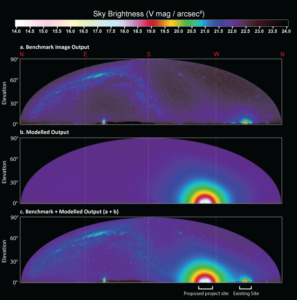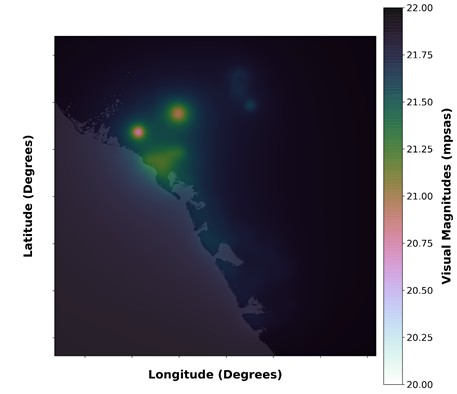Our scientists can build a unique, project-specific light model to accurately and precisely represent the intensities, wavelengths, and overall spatial visibility of your project's lighting. We can:
- Show the existing light environment alongside the additional artificial light likely to be emitted from the project;
- Help inform planning decisions before development by modelling the proposed lighting design;
- Model the reduction in intensity and visibility with distance from the light source;
- Determine the visibility of direct light and glow to threatened wildlife at nearby sensitive habitats;
- Model light under various lighting design scenarios so that the effectiveness of management measures can be demonstrated;
- Categorise future lighting development/changes to project and compare with baseline light monitoring; and
- Offer guidance on overcoming any environmental impact identified by the modelling.
 Do you need to predict artificial light emissions from your project as seen from the view of a sensitive site?
Do you need to predict artificial light emissions from your project as seen from the view of a sensitive site?
Purpose: Predict the intensity of light from a project across the hemisphere 'as viewed' from an area of interest (e.g. sensitive habitat).
Application: A panoramic quantified image of project-related artificial light is generated using available topography data and the project's lighting inventory. Light modelling can incorporate the existing visible light from a site if monitoring using our Sky42 cameras has been undertaken. This combined output provides a visualisation of the cumulative light to be predicted (i.e. current light + proposed project light). The cumulative light outputs can also be shown with, or without, proposed light mitigation measures, allowing their effectiveness at controlling light to be quantified (and visualised).
Output: Panoramic images (360° wide by 90° high) showing light intensity visible across the entire horizon and sky from a sensitive site. One panorama can be created for different lighting inventory scenarios or zones specific to the project and allow comparison between proposed mitigation measures, such as shielding of lights or changes in wavelength or lumen output.
 Do you need to predict light emissions over a large area?
Do you need to predict light emissions over a large area?
Method: Broadscale Heatmap
Purpose: To predict the impact of artificial light from a project site on the natural night sky over a wide area.
Application: Uses a generated lighting inventory of a project site to predict the impact of light emissions on the visibility of the night sky (overhead) as seen by humans over an area of interest. Useful for understanding light emissions on a regional scale as well as providing relevant data for IDA Dark Sky Place applications.
Output: An interpolated heatmap showing the intensity of light over the area of interest. One map is generated for each given scenario (e.g. Scenario 1 - all lights on, Scenario 2 - some lights off).
Do you need to understand line-of-sight visibility of lights from a sensitive habitat area?
Method: Viewshed Analysis
Purpose: Determine if lights from a project site will be directly visible from an area of interest.
Application: Using the location and height of lights, in addition to topography data, we can run a simple analysis using GIS to determine how many of the lights will be directly visible, where the light will be visible, and how much of a sensitive habitat area is exposed to the light.
Output: A map showing those areas that have visibility of specific project-related lights.
